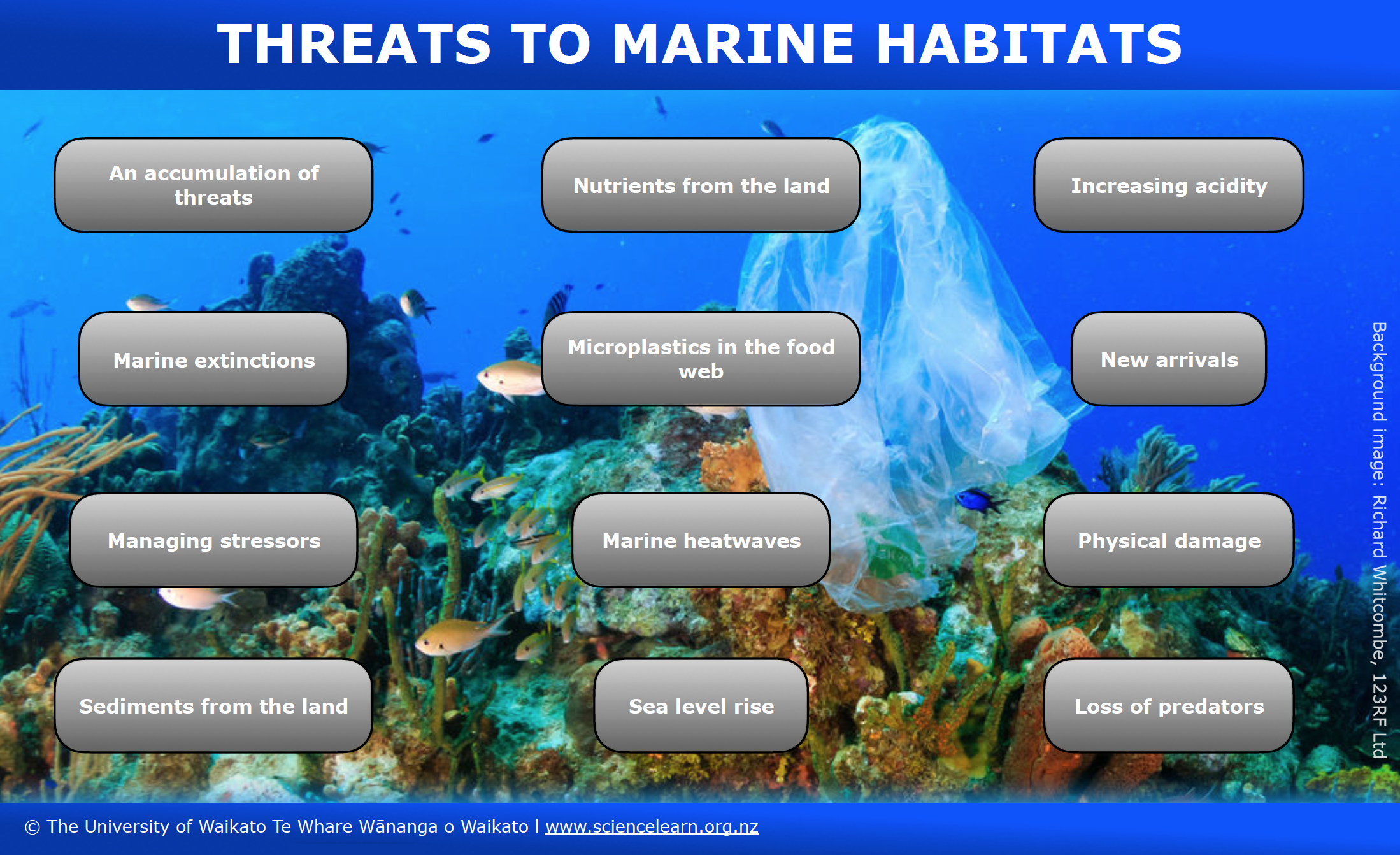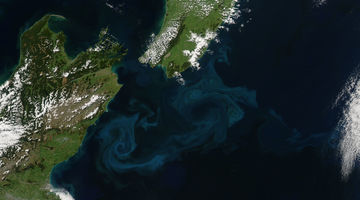Human actions at sea and on land are putting increasing pressure on the ocean and the species that live there.

Many human activities are threatening the health of our marine environment. Our actions at sea and on land are putting increasing pressure on the ocean and threatening many species with extinction.
Understanding how to minimise and manage these threats is one of the most important challenges facing us. Some can be managed through marine protected areas, while others will require us to work across society and sectors to protect our biodiversity and taonga species. Some habitats and species can recover quickly once threats are managed, whereas other threats are permanent and irreversible, such as extinction.
To use this interactive, move your mouse or finger over any of the labelled boxes and click to obtain more information.
Background image: Richard Whitcombe, 123RF Ltd.
Transcript
An accumulation of threats
None of the threats that face our oceans can be understood in isolation from each other. Threats do not have distinct boundaries and effects, and for many organisms, these sources of stress can overlap. Some threats may add directly onto each other, but most often, threats compound or multiply each other with far worse outcomes than if they were considered separately (see Ecosystem tipping points and stressors).
It can be very difficult to predict how a species or ecosystem will react when threats accumulate. This means that it is necessary to act with caution and minimise threats wherever we can to give species such as tuangi the best chance of survival.
Download the Department of Conservation infographic as a PDF.
Copyright: Department of Conservation
Marine extinctions
Extinction is the worst-case scenario when a species is facing threats, but it is also a threat in itself.
There are different types of extinction.
Global species extinction
This is the most widely known form of extinction when a species is completely gone from the planet – in other words, there are no surviving individuals (such as the moa or the Haast’s eagle). We classify threatened species based on how likely they are to become an extinct species. For example, fewer than 75 Māui dolphins exist. They are nationally critical and at a high risk of extinction.
Localised species extinction
Localised species extinction is when a species dies off in a specific area but is still present in other locations. For example, there are localised extinctions of bull kelp in New Zealand.
Functional species extinction
Functional extinction is when a species or habitat is found in such low numbers that they can’t fulfil their role in their ecosystem. Kōura (crayfish or rock lobster) can still be found at places in New Zealand, but in some areas such as the Hauraki Gulf, there are not enough breeding adults to maintain the population or play their important role as predators on shallow rock reefs.
Download the Department of Conservation infographic as a PDF.
Copyright: Department of Conservation
Managing stressors
Unfortunately, we can’t protect every species or habitat from every threat that they face. Just as threats compound and multiply each other, lessening or removing one threat can make a dramatic difference for the survival of a species.
Managing the multitude of threats that face our marine ecosystems is a complicated task. However, ecosystems are resilient and have a natural capacity to respond to challenges. By reducing one or more of our impacts on the ocean, we may avoid pushing an ecosystem or species beyond their ability to recover.
Download the Department of Conservation infographic as a PDF.
Copyright: Department of Conservation
Sediments from the land
Sedimentation is the process of small particles such as silt and mud building up in the ocean. Sedimentation is a natural result of erosion, which is accelerated by poor land management such as deforestation. Ecosystems can normally deal with sediments, but too much too quickly causes problems. These sediments block incoming sunlight, choke filter-feeders and carry with them toxins and heavy metals from the land.
Seagrasses are a biogenic habitat that are extremely threatened by oversedimentation. Although they only cover 0.1% of the ocean floor, they store up to 12% of the ocean’s carbon. They are declining 4–10 times faster than tropical forests but currently aren’t well represented within marine protected areas. When excess sediments arrive in seagrass habitats, the seagrasses can’t survive in reduced light levels and quickly die.
Download the Department of Conservation infographic as a PDF.
Copyright: Department of Conservation
Nutrients from the land
Nutrient levels within seawater are frequently used to monitor ecosystem health. Nutrients are essential for life to flourish – nitrogen, phosphorus and other nutrients contribute to healthy, productive ecosystems.
Too many nutrients cause harmful effects such as algae blooms. These blooms use the oxygen available in the water and deplete oxygen for other organisms, potentially causing dead zones where nothing grows.
This state of excess nutrients is called eutrophication. It has been shown to disrupt the balance of ecosystems, changing the types of organisms found and reducing overall diversity.
Download the Department of Conservation infographic as a PDF.
Copyright: Department of Conservation
Microplastics in the food web
Plastic pollution is quickly becoming one of the biggest threats to marine biodiversity, affecting more marine animals than oil spills, heavy metals or toxins. In New Zealand, 61% of all marine litter is plastic.
Large plastics pollution can cause harm when it is ingested or when animals become entangled.
Microplastics are pieces less than 5 mm in size and are significantly more difficult to remove from the environment. Ingesting plastic pieces has been shown to reduce nutritional intake from tiny zooplankton up to large bivalves like oysters. These tiny fragments absorb harmful chemicals and other pollutants, which accumulate within larger species. This accumulation of plastic and toxins can also put human health at risk.
Download the Department of Conservation infographic as a PDF.
Copyright: Department of Conservation
Marine heatwaves
Globally, oceans absorb 90% of the heat that we add to the atmosphere. This warming isn’t evenly spread throughout the oceans but arrives in ‘blobs’ that affect specific areas, similar to heatwaves in the weather. Marine heatwaves can be caused for a variety of reasons, such as reduced cooling of the ocean during warm winters.
This localised warming of the ocean has severe effects on marine life. Zooplankton (the small animals that are a large part of the food chain) will grow smaller and have less fat, meaning that fish and marine mammals will have fewer calories available to them. Warmer waters can mean more frequent harmful algal blooms and a better environment for pathogens such as bacteria to thrive.
As ocean temperatures continue to rise, tropical species will begin to move further from the equators towards the poles, displacing indigenous species such as bull kelp, which are less adaptable to rising temperatures.
Download the Department of Conservation infographic as a PDF.
Copyright: Department of Conservation
Sea level rise
Rising sea temperatures cause two problems – melting ice caps and glaciers add more water to the oceans and water expands as it warms. As sea levels rise, they cover shoreline nesting and breeding grounds for many species, such as seals, sea lions and shore birds.
This coastal squeeze is worsened by our activities to protect ourselves from sea level rise. Sea walls may temporarily protect our homes and communities from the rising waters, but they also stop sandy beaches and habitats such as mangroves from retreating up the land.
Download the Department of Conservation infographic as a PDF.
Copyright: Department of Conservation
Increasing acidity
Ocean acidification is the highest ranked threat to marine habitats. Carbon dioxide is absorbed from the atmosphere. Once in water, it is converted to carbonic acid, raising the acidity of the ocean. Naturally, the ocean is neutral or slightly basic, and the organisms within it are suited to these conditions. Scientists think that the ocean acidity has increased by about 30% in the last 100 years. In Otago, a 7.1% increase in ocean acidity has been observed since the turn of the century.
Shell-forming organisms such as shellfish, corals and some types of plankton are highly affected by the acidification. The carbonate that many organisms use to build their shells becomes less available as acidity increases, so many animals will struggle to grow their protective shells. Larvae may be deformed and unable to swim as they should, meaning that they will be unable to survive or settle in the appropriate habitat, thus decreasing the overall recruitment success of this species.
Download the Department of Conservation infographic as a PDF.
Copyright: Department of Conservation
New arrivals
The marine ecosystems of Aotearoa evolved over thousands of years in careful balance. Some new species arriving from overseas can quickly adapt to local conditions and threaten native species.
Invasive species that are able to establish can threaten existing ecosystems by competing with native species for space, shelter or food. Others can cause physical damage to the environment or infrastructure – for example, an invasive tubeworm is known for blocking pipes in the Hauraki Gulf.
Once a species has been introduced to our waters, it can be extremely difficult to remove them. This is why biosecurity must be diligent in checking ships’ hulls and ballast waters for unwanted guests.
Undaria pinnatifida is an invasive species of seaweed that was first found in New Zealand in 1987 and has become established in some areas in Southland. One mature plant can produce up to 700 million spores, which can live in the ocean for up to 2.5 years, making them very difficult to eradicate.
Download the Department of Conservation infographic as a PDF.
Copyright: Department of Conservation
Physical damage
There are a wide variety of activities that can cause physical damage to the seafloor. Boat anchors, trawling, harbour dredging, commercial and recreational fishing, seafloor mining and underwater cable repairs all have the potential to damage delicate seafloor communities. These practices need to be carefully managed and monitored.
Delicate ecosystems and habitats are not guaranteed to recover even decades after being damaged, so it is important that any new activities are undertaken with caution.
After being damaged, habitats like bryozoan thickets are more vulnerable to other threats, such as sedimentation and disease. This increased sensitivity is coupled with a loss of ecological function, such as the bryozoans’ role as a nursery for shellfish.
Download the Department of Conservation infographic as a PDF.
Copyright: Department of Conservation
Loss of predators
Healthy ecosystems are important to preserve biodiversity and support thriving fisheries.
Overfishing occurs when the balance of the ecosystem is altered. A decline or loss of the largest predators will change the predator-prey balance, which in turn disrupts the health of the ecosystem. These can result in dramatic changes, such as the kina barrens found when tāmure (snapper) and kōura (crayfish) are overfished. Large mature fish are not only more efficient predators but produce many more eggs than smaller fish, so the loss of the largest predators also reduces the number of young fish.
Download the Department of Conservation infographic as a PDF.
Copyright: Department of Conservation
Acknowledgment
This resource is another great collaboration between the Department of Conservation and the SLH. Infographics and text are supplied by DOC.


